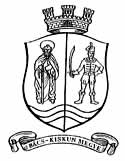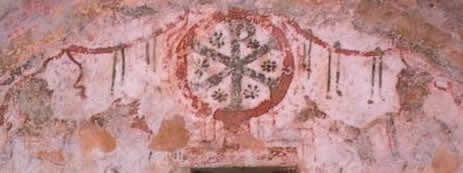|
|
|
2nd Conference of the
Hungarian Patristic Society on Ancient Christianity
|
Early Monasticism:
Practice and Theory
21-23 June 2002..
Scholae Piae, Kecskemét,
[This page is under construction.
For English/French/German titles of papers see the abstracts where
available {click on
title}]
21st June, Friday
14.00-15.00 Opening address
Vanyó László: Mózes-tipológia a IV-V. századi aszketikus
irodalomban
15.15 – 16.30 I. session
Chair: Nemeshegyi Péter
Baán Izsák: A remeteség életformája és viszonya a közösséghez keleten
Boros István: A szerzetesi élet teológiai és antropológiai alapja
Sándor Balázs: Három kép a szerzetesek szerepéről a Szentháromság és a
krisztológia dogmáinak megszilárdításában
16.30-16.45 Cofee break
16.45-17.55 II. session
Chair: Bugár István
Perendy László: Tatianosz és a keresztény szerzetesség kezdetei
Kendeffy Gábor: A két út tanítása Lactantiusnál
18.00 A “Középkori falképek a történelmi Gömör megyéből” című kiállítás
megnyitója a Gimnázium aulájában
19.00 Fogadás a Díszteremben
22nd June, Saturday
7.30-8.45 Breakfast
9.00-10.40 III. session
Chair: Perczel István
Hasznos Andrea: Graeco-coptica: „Templom” Pachomius irodalmában
Jakab Attila: Antoniosz és Pakhomiosz. Az aszketikus életmód különböző
megnyilvánulásai Egyiptomban a társadalomtörténeti megfontolások tükrében
Orosz Atanáz: A szerzetesség kezdetei - alexandriai pápa-szemmel.
Athanasziosz Antal-életrajzának sajátosságai
Heidl György: Az egység szemlélése. Remete Szent Antal és Szent Ágoston
10.40-11.00 Cofee break
11.00-12.40 IV. session
Chair: Jakab Attila
Somos Róbert: A vitázó Órigenész
Geréby György: A mentális ima két paradigmája: Evagrius Ponticus és
Loyolai Szt. Ignác
Perczel István: Az 553-as antiorigenista zsinat. Ki ítélt el kit, mikor,
hogyan és miért?
Pesthy Monika: A lüpé fogalma Evagriosznál
12.40-14.00 Lunch
14.00-15.15 V. session
Chair: Geréby György
Bugár István: Epiphaniosz a szerzetesi
lelkiségről: Az úgynevezett Testamentum Epiphanii a IV. századi spirituális
irányzatok tükrében
Tóth Péter: Lükopoliszi Szent János hagiográfiai dossziéja
Tóth Judit: A biosz philoszophikosz elemei Nüsszai Szent Gergely Vita
Macrinae-jában.
15.15-15.30 Cofee break
15.30-16.45 VI. session
Chair: Sághy Marianne
Hudák Krisztina: A gót szerzetesség problémája a IV. században
Frenyó Zoltán: Regula és történetfilozófia Szent Ágoston gondolkodásában
Puskely Mária: Valeria Melania Junior (383-439) mint korai
„szerzetes-modell”
16.45-17.00 Cofee break
17.00-18.15 VII. session
Chair: Somos Róbert
Sághy Marianne: A lerinumi paradicsom. Monasztikus erények az V. századi
gallo-római püspök-életrajzokban
Adamik Tamás: Szent Jeromos és a szerzetesrendek
Majorossy Imre Gábor: A trubadúriskolák aszketikus előképei
19.30-tól Dinner with table music
23rd June, Sunday
7.30-8.30 Breakfast
9 - 9.45
Kránitz Mihály: Órigenész mint a korai szerzetesség forrása
10.00-10.45 Closing address
Sponsored by:

BÁCS-KISKUN MEGYE ÖNKORMÁNYZATA
KECSKEMÉT MEGYEI JOGÚ VÁROS ÖNKORMÁNYZATA
EURÓPA ÉRTÉKRENDJÉÉRT PEDAGÓGIAI EGYESÜLET
KECSKEMÉTI PIARISTA RENDHÁZ ÉS ISKOLA
---------------------------------------------------------------------------------------------------------------------------------------------------------------------------------------------------------------------------------------------------------------------------------
|
ABSTRACTS
István M. Bugár, Epiphanius of Salamis
as a monastic author? The so‑called Testamentum Epiphanii in the
context of fourth‑century spiritual trends
Although Epiphanius is mainly
known as an ardent combatant of heresies, in his time he was reputed as
one of the most important monastic founders. His writings, however,
reveal almost nothing of his monastic activity and teaching. In this
paper I undertake to collect the scattered evidence and provide a
comprehensive analysis of a fragment attributed to Epiphanius, which
played a key role in the Iconoclastic Controversy and in modern debates
about the rise of a Christian cult of images.
First, I analyse briefly the sayings attributed to Epiphanius in the
alphabetical collection of the Apophthegmata Patrum, and draw
attention to one of them that has some parallel in an unpublished
fragment of a letter of Epiphanius. Next, using also the evidence from
the Vita Epiphanii, I show that the context of the fragment of
the Testamentum Epiphanii is obviously monastic. The terminology
of the short segment preserved is revealing both as for the dating and
the spiritual context of the ideas expressed therein. The fragment
proves to be intimately related to two spiritual movements of the fourth
century: the Macarian and the Evagrian monastic tradition. These two
movements that have often been opposed in scholarly literature appear to
share a number of key ideas and technical terms in common, which are
reflected also in the fragment under investigation. It is, however,
especially some central views of Evagrius that help us to understand the
Testamentum Epiphanii.
Since Epiphanius was an ardent opponent of both the Origenist monks (the
background of Evagrius) and the Messalian movement (the context of
Macarius/Symeon), the attribution of the fragment appears to be
problematic. It cannot, however, be excluded that much of the ideas
expressed there and the terminology were a common good of fourth century
monasticism in Egypt, Palestine and Syria, and thus their connection to
monastic Origenism or Messalinism was not obvious for Epiphanius. The
text is too short to tell more than this, and we have to leave open
whether the Testamentum is a fourth century text transmitted
under the safe name of Epiphanius to hide its original author, or it is
really by him. In any case, it is an important document of
fourth‑century spiritual trends and uniquely proves the connection of
Evagrian‑style monastic teaching and the opposition to the use of sacred
images in the Christian Church.
|
|

